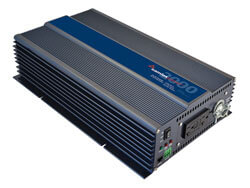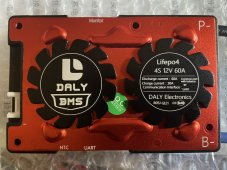Hey guys, I'm new here, so please be gentle on me. I'm trying to get my trailer dialed in and I've got some questions/need advice.
I've been watching Will's videos for a while and they've been a huge help, but I need help with one last piece of my puzzle before completing my system.
What I have:
Epever Tracer 30A MPPT Charge Controller with Display (MT50?)
2x 100W Solar Panels
VariCore 3.2V LiFePO4 200ah cells x4
Daly 60A 4S BMS
So, the charge controller is currently installed in the RV and I'm using 6v lead acid batteries.
I need to balance my lithium cells, and get them installed with the BMS. I also want to add a 3,000 watt inverter. My main goal is to be able to brew a pot of coffee without running a generator. The inverter will also be used for lighter loads, but I think making coffee would be my biggest load. Maybe limited microwave use?
So, I know that it won't be wise to run a 3k watt inverter through the 60A BMS, so I think a 200A isolating relay is my solution. But, in my head, I'm trying to figure out how to wire this in a way that it works. Let me know if I'm on the right track/completely wrong/missing something...
If I wire the inverter directly to the battery (through the relay) and use the BMS lead to switch the relay, it would technically cut off the battery during a low voltage or over voltage situation....BUT....If I have the solar charge controller supplying a charge on the same circuit, wouldn't that power keep the relay energized and keep the inverter connected in a situation where I would want the inverter to disconnect?
If I run everything through the relay (coach 12v power, inverter, charger) and the BMS cuts off the relay due to low voltage, then no power would be able to reach the batteries in order to charge.
I'm hoping you guys might be able to shine some light on this situation. I'm open to any kind of advice or workaround to make sure my system is safe. Also, if you have a recommendation on a good pure sine wave inverter, that would be appreciated as well.
Thanks for your help!
I've been watching Will's videos for a while and they've been a huge help, but I need help with one last piece of my puzzle before completing my system.
What I have:
Epever Tracer 30A MPPT Charge Controller with Display (MT50?)
2x 100W Solar Panels
VariCore 3.2V LiFePO4 200ah cells x4
Daly 60A 4S BMS
So, the charge controller is currently installed in the RV and I'm using 6v lead acid batteries.
I need to balance my lithium cells, and get them installed with the BMS. I also want to add a 3,000 watt inverter. My main goal is to be able to brew a pot of coffee without running a generator. The inverter will also be used for lighter loads, but I think making coffee would be my biggest load. Maybe limited microwave use?
So, I know that it won't be wise to run a 3k watt inverter through the 60A BMS, so I think a 200A isolating relay is my solution. But, in my head, I'm trying to figure out how to wire this in a way that it works. Let me know if I'm on the right track/completely wrong/missing something...
If I wire the inverter directly to the battery (through the relay) and use the BMS lead to switch the relay, it would technically cut off the battery during a low voltage or over voltage situation....BUT....If I have the solar charge controller supplying a charge on the same circuit, wouldn't that power keep the relay energized and keep the inverter connected in a situation where I would want the inverter to disconnect?
If I run everything through the relay (coach 12v power, inverter, charger) and the BMS cuts off the relay due to low voltage, then no power would be able to reach the batteries in order to charge.
I'm hoping you guys might be able to shine some light on this situation. I'm open to any kind of advice or workaround to make sure my system is safe. Also, if you have a recommendation on a good pure sine wave inverter, that would be appreciated as well.
Thanks for your help!
Last edited:




